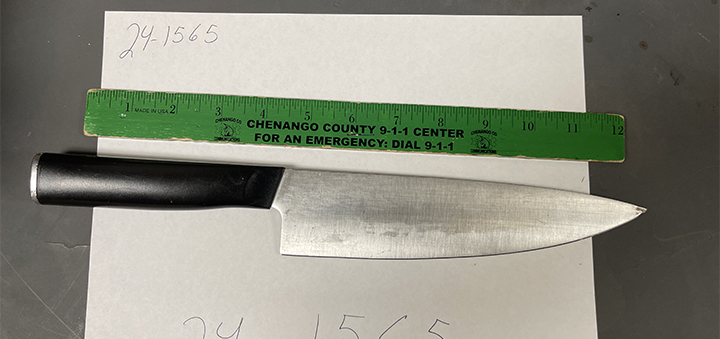Tilting At Windmills: The Case Of The Itsy Bitsy Spider
Published:
April 29th, 2022
By:
Shelly Reuben

Oh me. Oh my. Someone is telling a lie!
Or, at least, that’s what our insurance client suspected when she asked Charles G. King Associates if we could investigate a case that was not an arson.
Charlie said, “Sure. Why not?”
I thought it would be fun, too.
Our claims representative, Felicity Moulton, said that their policyholder, Alveretta’s Boutique, was a small shop on a busy boulevard in Queens. It had minimal frontage (just a plate glass window and a door), but was long and narrow, went very far back, and sold accessories and clothes. Felicity explained that the insurance claim was for water damage.
Purportedly, “a very, very large woman living in the apartment above the store had been painting her bathroom. She stepped on her toilet tank to get at a high spot when the tank pulled away from the wall and dumped five to eight gallons of water on the floor. The water then seeped through the flooring to the ceiling of the boutique below.”
After Miss Alveretta called in the claim, Felicity Moulton sent one of her company adjusters, Felix Jasper, to the boutique to evaluate the damage. For those lucky enough never to have suffered a fire, flood, or tree falling on your roof, an adjuster’s job is to look things over at the insured’s home, office, vehicle (wherever), and decide how much they should pay the policyholder for the losses incurred.
As assigned, Felix visited Alveretta’s Boutique, and he concluded that there had been $80,000 worth of water damage, the worst of which was to the boutique’s collection of shoes. To substantiate his assessment, he submitted two photos of sodden boxes. Not photographs of shoes, mind you. Just boxes.
Reviewing Felix’s report, Felicity Moulton decided that $80,000 was a whole lot of money to pay out for wet cardboard containers.
Hence, her call asking us to investigate the case.
When Charlie and I first got to the scene, we discovered a round stain about the circumference of a water glass in the acoustical ceiling tile above a circular clothing rack. A quick inspection of the clothes on the rack proved that all of it was pristine. Not a droplet of H20 had plopped on a blouse, a dress, a sweater, or a vest.
The shoe department, however, which was supposed to have suffered the most damage, was so far in the back of the store that it would have taken a tidal wave to reach it from where the leak (supposedly) occurred.
Ah ha! Charlie and I thought simultaneously. “I smell a rat!”
Time to delve further into the Tale of the Toppled Toilet Tank on the Second Floor.
Charlie found ladder in a closet, and while I held it, he pushed aside the ceiling tile with the small stain. Since the ladder wasn’t tall enough for him to poke his head through, he raised his point and shoot camera through the opening, and doing a blind 360⁰ degree rotation, took pictures of everything he couldn’t see.
We had the photos printed right away and brought them back to our office. The next part of the job was mine. I spread them out in front of me, and concentrated my attention on the mystery pictures above the boutique’s ceiling. I matched item to item and edge to edge, and created a panorama of the floor joists through which, if the claim was valid, water had to have flowed. One of the photos in particular caught my attention, and as soon as I realized what it was, I rushed to Charlie’s desk, thrust it in front of him, and said, “Isn’t this a spider web?”
At which point Charlie again thought that extra thought and went that extra mile. He got the phone number for Museum of Natural History, asked to speak to the chief entomologist, and was put through to senior museum specialist, Dr. Louis Sorkin,. Charlie asked Dr. Sorkin he would be willing to look at a picture of a spider web for us. The epitome of graciousness, the good doctor said, “Yes.” Before Charlie drove to the museum, though, he had the photograph enlarged considerably, and as soon as he handed it to Dr. Sorkin, our entomological hero said, and I quote, “That’s a theridiid spider web. Possibly a Parasteatoda or Steatoda web.
CHARLIE: How do you know that?
DR. SORKIN: Steatoda triangulosa and Parasteatoda tepidariorum are common house spiders.
CHARLIE: Can you tell me how old the spider web is?
DR. SORKIN (without hesitation): One year. Possibly two.
CHARLIE: How do you know that?
DR. SORKIN: This kind of spider constantly cleans out its own web, and by the amount of debris in this dormant web, it has been around a while. Maybe months. Maybe years.
CHARLIE: In your professional opinion, could the web have sustained a deluge of water?
DR. SORKIN: Of course not. There are no tears, and the web has never even been repaired.
After we passed on all of this information to Felicity Moulton, she thanks us, denied the claim, and the case went away.
Which brings us back to Felix Jasper, the company adjuster who had valued the loss at $80,000.
What had he been up to?
Had Felix known Miss Alveretta before he was sent to evaluate the damage to her boutique? Had their eyes met across a rack of discount blouses, and they recognized each other as kindred souls? Had the two of them colluded to split the proceeds if and when the fraudulent claim was paid?
Alas. I do not know.
Like where are Jimmy Hoffa, Judge Crater, and the green argyle sock you last saw in the washing machine, it is another one of those mysteries that probably never will be solved.
Copyright © Shelly Reuben, 2022. Shelly Reuben’s books have been nominated for Edgar, Prometheus, and Falcon awards. For more about her writing, visit www.shellyreuben.com
Author: Shelly Reuben - More From This Author
Comments






